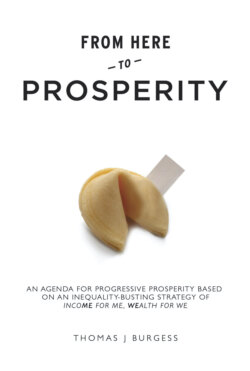From Here to Prosperity

Реклама. ООО «ЛитРес», ИНН: 7719571260.
Оглавление
Thomas Burgess. From Here to Prosperity
Contents
Acknowledgements
Preface
PART I. The Challenge for Change
CHAPTER 1. Where Are We Now?
1.1 Extreme inequality and persistent poverty
Persistent Poverty
1.2 Slow economic progress
1.3. Government isn’t working (for us)
Summary
CHAPTER 2. Radical Rethink
2.1 Austerity to prosperity
What is prosperity?
Measuring progress to prosperity
Platform for prosperity
2.2 Tax as a toolbox
Avoid it if you can
Left the country
High cost of collection
Why tax?
Public revenue without taxation?
Reform of the revenue
2.3 Revolution or evolution?
The pitchforks are coming
History lessons
Freak out
Bold policies
Creeping communism?
Leading the team
Summary
PART II. The Agenda for Progressive Prosperity
CHAPTER 3. Turnaround Taxation
3.1 Income for me
Stage 1: Immediate action, abolish Income Tax for the majority
Stage 2: Reduce payroll taxes
Stage 3: Realign sales taxes
Summary
3.2 Wealth for we
Stage 1: Introduce Personal Asset Contribution
Stage 2: Abolish Capital Gains Tax
Summary
3.3 Location, location, location!
Summary
Summary of Chapter 3
CHAPTER 4. Socially Responsible Capitalism
4.1 Fair pay all the way
Summary
4.2 Profits for people
Summary
4.3 Working together
Summary
Summary of Chapter 4
CHAPTER 5. Foundations for the Future
5.1 Integrated infrastructure
Summary
5.2 Excellence in education
Summary
5.3 Health and welfare of the nation
1 Healthcare
2 Welfare
Poverty plan
Health and welfare summary
Foundations for the future summary
PART III. Moving Forward
CHAPTER 6. Hope into Reality
6.1 Towards progressive prosperity
1 Reduced Inequality and poverty
2 Greater economic progress
3 Democracy restored
Summary
6.2 Convincing the confused
1 The message to the majority
2 Reasoning with the Rich
3 Winning policies for politicians
Summary
6.3 Campaign for change
1 A tax or a charge?
2 Tax needs to be fair
3 Tax and spending needs to be transparent and well managed
Summary
Summary of Chapter 6
CHAPTER 7. And Now, It Is up to Us
7.1 Body of evidence
7.2 The time is now
7.3 Next steps
Отрывок из книги
‘Burgess presents a much-needed path to engage both the wealthy and everyone else. It isn’t punitive, it is inclusive. It isn’t billionaire bashing, it’s bridge building. The principle of ‘Income for me/wealth for we’ is not just practical, it is executable. This book outlines an agenda to build balance again with greater opportunity, a healthy middle class and a productive environment for the continued creation of wealth for the benefit of all, not just the few.’
Chuck Collins, author of Born on Third Base: A One Percenter Makes the Case for Tackling Inequality, Bringing Wealth Home, and Committing to the Common Good, Senior Scholar, Institute for Policy Studies, Washington DC, and co-editor of Inequality.org. Co-founder of Wealth for the Common Good and Patriotic Millionaires
.....
Not only is economic growth dismally slow and well behind our true capability, our infrastructure is crumbling. In the USA, total public spending on transport and water infrastructure has fallen steadily since the 1960s and now stands at 2.4% of GDP. Europe, by contrast, invests 5% of GDP in its infrastructure, while China is racing into the future at 9%. America’s spending as a share of GDP has not come close to European levels for over 50 years. Although it still builds roads with enthusiasm, according to the OECD’s International Transport Forum, the USA spends considerably less than Europe on maintaining its roads. In 2006 America spent more than twice as much per person as Britain on new construction; but Britain spent 23% more per person maintaining its roads. From personal experience, the UK may have potholes and cracks thanks to its changeable weather, but the roads in California seem no better.
There is little relief either for the weary traveller on America’s rail system. The absence of true high-speed rail is a continuing embarrassment to the nation’s rail advocates. America’s fastest and most reliable line, the north-eastern corridor’s Acela, averages a sluggish 70 miles per hour for the 454 miles between Washington and Boston so it is not technically a high speed train by European standards. The French TGV from Paris to Lyons runs at an average speed of 140mph. America’s trains are not just slow; they are late. Where European passenger service is punctual around 90% of the time, American short-haul service achieves just a 77% punctuality rating. Long-distance trains are even less reliable. But while the Federal Government seems to understand the necessity of the rail network as it allocated $8 billion for high-speed rail projects as part of the 2009 stimulus, at least three states (Florida, Ohio and Wisconsin) sent the funds back, claiming it was wasteful spending.
.....